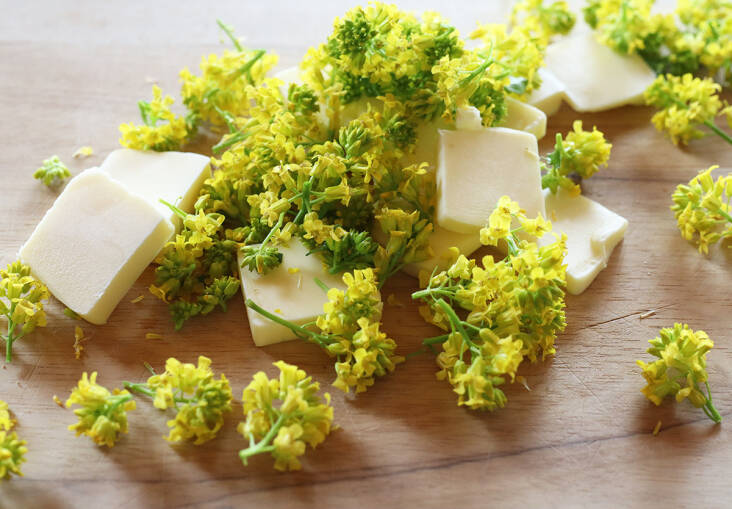In late spring yellow fireworks light up damp, green fields, highway verges, and stream edges. Wintercresses are in vivid bloom, bursting from months-long dark green anonymity in a blaze of yellow. Whether the plants are a weed or a welcome seasonal vegetable depends on your wintercress point of view. Their firm, peppery leaves and tiny, cruciferous flowers are a spicy addition to any meal, making these opportunistic wild brassicas a welcome spring treasure for your forage basket, but also a worthy denizen of any vegetable garden.
Photography by Marie Viljoen.

Wintercress is not one plant but three, all members of the mustard family: Barbarea vulgaris is a weed introduced from Europe; B. verna, (upland cress) is Eurasian in origin; and B. orthoceras (American yellow rocket) is native to North America and Asia, occurring mostly on the West Coast, and endangered in New England. Other common names—sometimes deployed interchangeably—for these spicy, edible spring greens include yellow rocket, garden rocket, bitter cress, land cress, and creasy greens.

Each of the wintercresses packs some horseradish heat, has firm leaves, tender, edible buds, and pretty, yellow, cruciform flowers. If you want to tell them apart, regard the leaves, closely: the basal (lower) leaves of B. verna have four or more lateral lobes on each side of a leaf’s midrib. The leaf of B. vulgaris leaves has four or fewer. The native B. orthoceras has a fringe of sparse hairs on some leaf auricles (botanically, an auricle is a small ear-like projection at the base of a leaf). Fortunately, the differences have no bearing on their edibility.

Wintercresses are excellent kitchen garden plants. Barbarea vulgaris requires plenty of water but will produce leaves through the year if you keep cutting it back and do not allow it to bloom. It can be grown as an annual, though it is a short-lived perennial. Unlike B. vulgaris, upland cress (B. verna, also marketed as creasy greens) remains full and robust with less water and also flourishes in humid summers, which is not typical of the Brassica family. It germinates very easily. Grow in full sun to semi-shade, sowing a couple of weeks before the last frost date in your area, through late fall.

The hot leaves of all wintercresses are excellent raw, especially with strong partners like grapefruit or pomelo, raw onion, crispy fried shallots, or fermented black beans. Tuck the leaves into a grilled cheese sandwich or lacto-ferment them to appreciate how that brassica sting evolves sweetly in the company of good bacteria. Or chop the raw leaves finely and smash them into good butter. The hot spice flavor mellows a little when the leaves cooked (and especially if blanched) but still provide a backdrop of spice to the soups or slow-cooked stews that comfort us when the weather is still cold.


Before the flowers open, the tender, budded stems are a choice vegetable, like a more pliable broccolini. Briefly blanched, they are a nourishing side dish, mineral-rich addition to an omelet or miso-savory broth, or added in a tangle to a noodle bowl.


By late spring wintercress stems have shot up, branched minutely, and are festooned with tiny, acid-yellow flowers, which are the mildest part of the piquant plant, and an absolute delight in sandwiches, summer rolls, salads, and compound butters.


Wintercress butters (leaf and flower) are an easy topping for open sandwiches, or a finishing touch for grilled salmon, or just-boiled, piping hot potatoes.


Wintercress Flowers with Cold Somen Noodles
For 1
In late spring, when the bright flowers of wintercress are in profuse bloom, this simple bowlful of thin Japanese noodles is packed with their satisfying flavor.
- 3 oz somen noodles
- 1 tablespoon neutral oil
- 2 cups wintercress flowers and leaves
- 1 tablespoon soy sauce
- 1 teaspoon roasted ramp leaf oil (see our previous ramp story for the recipe)
- ½ teaspoon lemon juice
- ¼ teaspoon sugar
- ¼ teaspoon toasted sesame oil
Bring a potful of water to a boil. Drop the somen noodles into the boiling water and cook for around 2 minutes or until just-tender. Strain and refresh the noodles in cold water, and drain well.
Meanwhile, warm the oil in a small skillet over medium-high heat. Add the wintercress flowers and leaves. Cook until just wilted—about 1 minute. Add the soy, sugar, and lemon juice. Stir, and cook another minute. Turn off the heat. Add the sesame oil to the skillet, stir one more time and pour this brief sauce over the noodles. Toss well. Plate, and slurp.
See also:
- 11 Favorites: Edible Flowers of Spring
- Chickweed: Taste the Stars
- Forest Farming Is the Future (for Ramps)












Have a Question or Comment About This Post?
Join the conversation